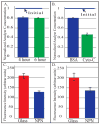Protein Separation and Hemocompatibility of Nitride Membranes in Microfluidic Filtration Systems
- PMID: 30441657
- PMCID: PMC6241304
- DOI: 10.1109/EMBC.2018.8513538
Protein Separation and Hemocompatibility of Nitride Membranes in Microfluidic Filtration Systems
Abstract
Improving the health outcomes for end-stage renal Disease (ESRD) patients on hemodialysis (HD) requires new technologies for wearable HD such as a highly efficient membrane that can achieve standard toxic clearance rates in small device footprints. Our group has developed nanoporous silicon nitride (NPN) membranes which are 100 to 1000 times thinner than conventional membranes and are orders-ofmagnitude more efficient for dialysis. Counter flow dialysis separation experiments were performed to measure urea clearance while microdialysis experiments were performed in a stirred beaker to measure the separation of cytochrome-c and albumin. Hemodialysis experiments testing for platelet activation as well as protein adhesion were performed. Devices for the counter flow experiments were constructed with polydimethylsiloxane (PDMS) and a NPN membrane chip. The counter flow devices reduced the urea by as much as 20%. The microdialysis experiments showed a diffusion of ~ 60% for the cytochrome-c while clearing ~ 20% of the Albumin. Initial hemocompatibility studies show that the NPN membrane surface is less prone to both protein adhesion and platelet activation when compared to positive control (glass).
Figures



Similar articles
-
Second Generation Nanoporous Silicon Nitride Membranes for High Toxin Clearance and Small Format Hemodialysis.Adv Healthc Mater. 2020 Feb;9(4):e1900750. doi: 10.1002/adhm.201900750. Epub 2020 Jan 15. Adv Healthc Mater. 2020. PMID: 31943849 Free PMC article.
-
Ultrathin silicon membranes for wearable dialysis.Adv Chronic Kidney Dis. 2013 Nov;20(6):508-15. doi: 10.1053/j.ackd.2013.08.001. Adv Chronic Kidney Dis. 2013. PMID: 24206603 Review.
-
Nanoporous membrane robustness / stability in small form factor microfluidic filtration system.Annu Int Conf IEEE Eng Med Biol Soc. 2016 Aug;2016:1955-1958. doi: 10.1109/EMBC.2016.7591106. Annu Int Conf IEEE Eng Med Biol Soc. 2016. PMID: 28268711 Free PMC article.
-
Cellulose acetate-polyvinyl alcohol blend hemodialysis membranes integrated with dialysis performance and high biocompatibility.Mater Sci Eng C Mater Biol Appl. 2021 Jul;126:112127. doi: 10.1016/j.msec.2021.112127. Epub 2021 Apr 23. Mater Sci Eng C Mater Biol Appl. 2021. PMID: 34082944
-
[Renal replacement therapy by hemodialysis: an overview].Nephrol Ther. 2009 Jul;5(4):306-12. doi: 10.1016/j.nephro.2009.03.001. Epub 2009 May 28. Nephrol Ther. 2009. PMID: 19481513 Review. French.
Cited by
-
Second Generation Nanoporous Silicon Nitride Membranes for High Toxin Clearance and Small Format Hemodialysis.Adv Healthc Mater. 2020 Feb;9(4):e1900750. doi: 10.1002/adhm.201900750. Epub 2020 Jan 15. Adv Healthc Mater. 2020. PMID: 31943849 Free PMC article.
References
-
- USRDS. 2016 USRDS annual data report: Epidemiology of kidney disease in the United States. National Institutes of Health, National Institute of Diabetes and Digestive and Kidney Diseases; Bethesda, MD: 2016.
-
- Foley RN, Gilbertson DT, Murray T, Collins AJ. Long interdialytic interval and mortality among patients receiving hemodialysis. (in eng), no. 1533–4406 (Electronic), 20111013 DCOM- 20111019 2011. - PubMed
-
- Turin TC, Tonelli M, Manns BJ, Ravani P, Ahmed SB, Hemmelgarn BR. Nephrol Dial Transplant. 8. Vol. 27. England: 2012. Chronic kidney disease and life expectancy; pp. 3182–6. - PubMed
-
- DesOrmeaux JP, et al. Nanoporous silicon nitride membranes fabricated from porous nanocrystalline silicon templates. 2014 (in eng), no. 2040–3372 (Electronic), 20140822. - PubMed
Publication types
MeSH terms
Substances
Grants and funding
LinkOut - more resources
Full Text Sources
Medical
